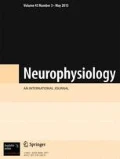When studying the spatial organization of ongoing EEG, we calculated the coefficients of coherence, Kcoh, in 60 healthy adults of both sexes characterized by different locus of subjective control, LC. The latter psychological trait was diagnosed using the Rotter questionnaire. Recording of EEG (21 leads; positions of the electrodes according to the 10-20 system) was performed in the resting state with the eyes closed; Kcoh values were calculated for 20 lead pairs. Despite natural high interindividual variability, greater Kcoh values for oscillations of all EEG frequency ranges and for the entire EEG spectrum (especially in fronto-central leads) were more frequently observed in the subgroup of subjects with internal LC (internals). Externals were characterized by greater numbers of relations with low Kcoh values, while moderate and significant levels of coherence, especially for high-frequency EEG rhythms, were more typical of internals. The latter subjects more frequently and significantly differed from externals by greater Kcoh values in lead pairs F3-C3, F4-C4, and Fp2-F4. In pairs O1-O2 and P4-O2, Kcoh in internals were practically always smaller. The index of general internality demonstrated only positive correlations with the Kcoh values for δ, β, and γ EEG oscillations.
Similar content being viewed by others
References
J. B. Rotter, “Internal versus external control of reinforcement: A case history of a variable,” Am. Psychologist, 45, No. 4, 489-493 (1990).
B. De Brabander and C. H. Declerck, “A possible role of central dopamine metabolism associated with individual differences in locus of control,” Person. Individ. Differ., 37, No. 4, 735-750 (2004).
C. H. Declerck, Ch. Boone, and B. De Brabander, “On feeling in control: A biological theory for individual differences in control perception,” Brain Cognit., 62, No. 2, 143-176 (2006).
R. K. Johnson and R. G. Meyer, “The locus of control construct in EEG alpha rhythm feedback,” Consult. Clin. Psychol., 42, No. 6, 913 (1974).
W. J. Goesling, C. May, D. Lavond, et al., “Relationship between internal and external locus of control and the operant conditioning of alpha through biofeedback training,” Percept. Motor Skills, 39, No. 3, 1339-1343 (1974).
I. G. Mosyagin, Psychophysiological Regularities of Adaptation of Navy Specialists, Abstract of thesis for Doct. Med. degree [in Russian], Arkhangel’sk (2007).
I. N. Konareva, “Locus of psychological control and peculiarities of event-related EEG potentials,” Neurophysiology, 43, No. 5, 443-452 (2011).
I. N. Konareva, “Locus of psychological control and characteristics of the EEG frequency components,” Neurophysiology, 43, No. 6, 534-542 (2011).
Ye. F. Bazhin, Ye. A. Golykina, and A. M. Étkind, “Method for estimation of the level of subjective control,” Psikhol. Zh., 5, No. 3, 152-162 (1984).
D. M. Tucker, D. L. Roth, and T. B. Bair, “Functional connections among cortical regions: topography of EEG coherence,” Electroencephalogr. Clin. Neurophysiol., 63, No. 3, 242-250 (1986).
N. S. Kurova and Ye. A. Cheremoushkin, “Spectral characteristics of EEG at complication of the context of cognitive activity,” Zh. Vyssh. Nerv. Deyat., 56, No. 2, 211-218 (2006).
W. Klimesch, “EEG alpha and theta oscillations reflect cognitive and memory performance: a review and analysis,” Brain Res. Rev., 29, Nos. 2/3, 169-195 (1999).
F. C. J. Stevens, C. D. Kaplan, R. W. H. M. Ponds, and J. Jolles, “The importance of active lifestyles for memory performance and memory self-knowledge,” Basic Appl. Social Psychol., 23, No. 2, 137-145 (2001).
E. Tulving, “Episodic memory: from mind to brain,” Annu. Rev. Psychol., 53, No. 1, 1-25 (2002).
R. Swenson and D. M. Tucker, “Multivariate analysis of EEG coherence: stability of the metric, individual differences in patterning and response to arousal,” Biol. Psychol., 17, No. 1, 59-75 (1983).
R. W. Thatcher, P. J. Krause, and М. Hrybyk, “Corticocortical associations and EEG coherence: a twocompartmental model,” Electroencephalogr. Clin. Neurophysiol., 64, No. 2, 123-143 (1986).
T. Koeda, M. Knyazeva, C. Njiokiktjien, et al., “The EEG in acallosal children. Coherence values in the resting state: left hemisphere compensatory mechanism?” Electroencephalogr. Clin. Neurophysiol., 95, No. 6, 397-407 (1995).
D. T. Stuss and B. Levine, “Adult clinical neuropsychology: lessons from studies of the frontal lobes,” Annu. Rev. Psychol., 53, No. 1, 401-433 (2002).
Author information
Authors and Affiliations
Corresponding author
Rights and permissions
About this article
Cite this article
Konareva, I.N. Locus of Subjective Control: Peculiarities of the Coherence of EEG Activity in the Resting State. Neurophysiology 45, 258–265 (2013). https://doi.org/10.1007/s11062-013-9364-7
Received:
Published:
Issue Date:
DOI: https://doi.org/10.1007/s11062-013-9364-7


